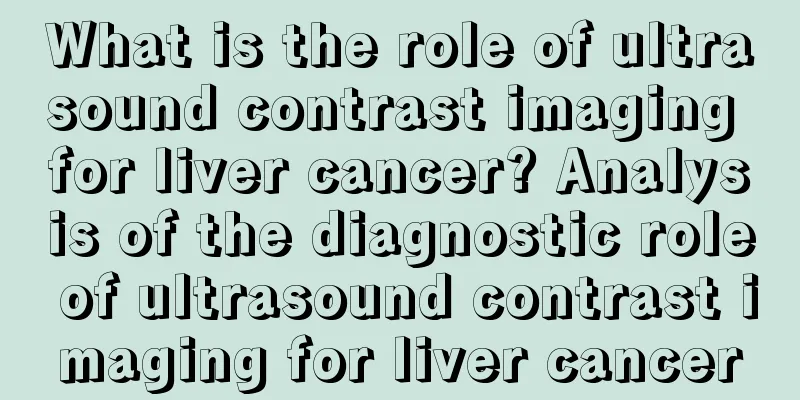What is the role of ultrasound contrast imaging for liver cancer? Analysis of the diagnostic role of ultrasound contrast imaging for liver cancer

|
Ultrasound contrast imaging of liver cancer, also known as acoustic contrast imaging, is a technology that uses contrast agents to enhance backscattered echoes, significantly improving the resolution, sensitivity and specificity of ultrasound diagnosis. Ultrasound contrast imaging technology is often used in the diagnosis and differential diagnosis of liver tumors. The diagnostic process is as follows: after the space-occupying lesions of the liver are found on an ordinary ultrasound machine, ultrasound contrast agent is injected through a peripheral vein to observe the internal enhancement of the liver space-occupying lesion within a few minutes. Since the blood supply characteristics of malignant liver tumors are different from those of benign lesions, the difference in ultrasound enhancement can be used to diagnose and differentially diagnose malignant liver tumors. At present, ultrasound contrast imaging has been widely used in the detection and qualitative diagnosis of solid organ tumors. It is superior to conventional ultrasound and spiral CT in many aspects. Especially in the detection of sub-centimeter lesions below 1 cm, the diagnostic ability of ultrasound contrast imaging can be better than or at least have the same sensitivity as spiral CT. Compared with spiral CT and MRI (magnetic resonance imaging), ultrasound contrast imaging has more advantages, such as good safety, no allergic reaction, real-time, and relatively low examination costs. Ultrasound angiography can dynamically observe the dynamic changes of blood flow in the arterial phase, portal venous phase, and delayed phase of liver lesions, and diagnose and differentiate liver lesions based on the characteristic manifestations of various lesions. For example, hepatocellular carcinoma often presents a fast-in-fast-out performance, with complete enhancement in the early arterial phase and low echoes in the portal venous phase and delayed phase, which can be differentiated from benign lesions in most cases. |
<<: What are the symptoms of early lung cancer? Summary of early symptoms of lung cancer
Recommend
Why are there itchy bumps on my body?
In summer, because the weather is hot and humid, ...
Some body parts are healthier when they are “dirtier”
Please be gentle on your face Many people mistake...
How to check anxiety disorder
When people suffer from anxiety disorders, it wil...
Analysis of the early symptoms of cervical cancer
Cervical cancer is a common gynecological disease...
Experts briefly analyze the classification of common malignant melanoma
Malignant melanoma is a surgical disease that cau...
What are the causes of lung cancer
Lung cancer is a killer of our body, and it serio...
A 56-year-old man had pain on the left side of his waist and thought it was a kidney stone. The doctor took a look at the CT scan and was shocked and broke out in a sweat
One day, Mr. Li, 55 years old, suddenly felt seve...
Unsteady walking, dizziness, body shaking
Walking is something we need to do every day. We ...
What should be done to prevent hamartoma
Nowadays, the incidence of malignant tumors is ge...
What foods to eat for hemorrhoids
Hemorrhoids are a very common disease. Such a dis...
Blood blisters on the penis
If a man finds blood blisters on his penis during...
How to effectively remove whiteheads on the nose?
How to effectively remove the whiteheads on the n...
There is a lump on the collarbone of my neck
Many women care about the shape of their clavicle...
What are the dangers of tongue cancer in the elderly
What are the hazards of tongue cancer in the elde...
The corner of my mouth twitched suddenly. What's going on?
Many children experience sudden twitching of the ...









